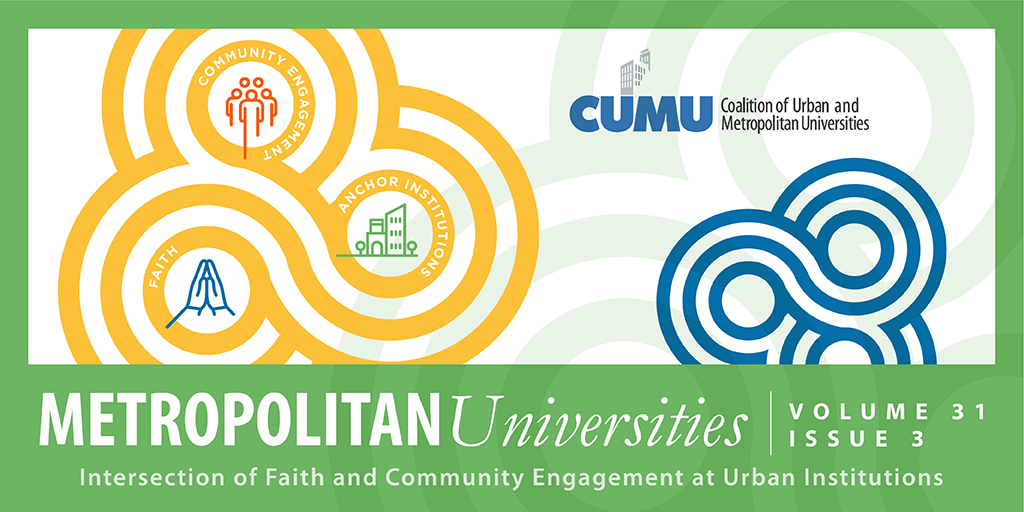The Application of Faith and Learning
Faith-Based Anchor Institutions and Community Engagement
DOI:
https://doi.org/10.18060/23986Keywords:
community-university partnerships, experiential learning, cultural humility, service-learning, faith integrationAbstract
Higher education institutions face many competing priorities and are still expected to serve the public good. Faith-based institutions, in particular, aim to meet a faith-inspired calling and serve the communities in which they are situated while guiding students in their faith formation by integrating service and academic priorities. In this paper, the authors explore, through a case study methodology, the unique positionality of Messiah University, a faith-based university located near the capital city of Harrisburg, PA. Specifically, this study explores the impact of a community engaged course with an urban nonprofit agency.
References
Agapé Center for Service and Learning. (2012). 2011 Annual Report. Mechanicsburg, PA:
Messiah University.
Benson, L., Harkavy, I. R., & Puckett, J. L. (2007). Dewey’s dream: Universities and
democracies in an age of education reform: Civil society, public schools, and democratic
citizenship. Philadelphia, PA: Temple University Press.
Benson, L., Harkavy, I., Puckett, J., Hartley, M., Hodges, R., Johnston, F., & Weeks, J.
(2017). Knowledge for social change: Bacon, Dewey, and the revolutionary transformation of research universities in the twenty-first century. Philadelphia, PA: Temple University Press.
Brethren Housing Association. (2019-2020). Mission and history. https://www.bha-pa.org/about
Cantor, N., Englot, P., Higgins, M. (2013). Making the work of anchor institutions stick:
Building coalitions and collective expertise. Journal of Higher Education Outreach and
Engagement. 17(3), p. 17-46.
Creswell, J. W. (2018). Research design: Qualitative, quantitative and mixed methods
approaches (5th ed.). Thousand Oaks.
Creswell, J. W., & Miller, D. L. (2000). Determining validity in qualitative inquiry. Theory Into
Practice, 39(3), 124-130.
Culp, B. (2016). Social justice and the future of higher education kinesiology. Quest, 68(3),
–283.
de Groot, M., Alexander, K., Culp, B., & Keith, N. (2015). Experiential learning in
kinesiology: A student perspective. Pedagogy in Health Promotion, 1(3), 123–133.
Dewar, Margaret E., and Claudia B. Isaac. 1998. “The Potentially Transforming Experience of
Community/University Collaboration,” Journal of Planning Education and Research 17, 4:334–347.
Dubb, S., McKinley, S., & Howard, T. (2013). The anchor dashboard: Aligning institutional
practice to meet low-income community needs. The Democracy Collaborative at the University of Maryland. Retrieved from http://community-wealth.org/sites/clone.communitywealth.org/files/downloads/AnchorDashboardCompositAnchor.pdf
Eyler, J., Giles, D. E., Jr., Stenson, C. M., & Gray, C. J. (2001). At a glance: What we know
about the effects of service-learning on college students, faculty, institutions and communities, 1993–2003. Nashville, TN: Vanderbilt University.
Eyler, J., Giles, D., & Schmiede, A. (1996). A practitioner’s guide to reflection in service-learning: Student voices and reflection. Nashville, TN: Vanderbilt University.
Gray, B. (2000). A critique of assessing collaborative efforts: Assessing inter-organizational
collaboration. In D. Faulkner & M. De Rond (Eds.), Cooperative strategy (pp. 243–261). Oxford: Oxford University Press.
Haynes, S. R. (Ed.) (2005). Professing in the postmodern academy: Faculty and the future of
church related colleges. Waco, TX: Baylor University Press.
Hodges, R. A., & Dubb, S. (2020). The road half traveled: University engagement at a
crossroads. Michigan State University Press.
Huber, M. T., & Hutchings, P. (2004). Integrative learning: Mapping the terrain. Washington,
DC: Association of American Colleges & Universities and The Carnegie Foundation for the Advancement of Teaching.
Jacob, W., Sutin, S., Weidman, J., & Yeager, J. L. (2015). Community Engagement in Higher
Education: International and Local Perspectives. DOI: 10.1007/978-94-6300-007-9_1.
Jacoby, B. (2014). Service-learning essentials: Questions, answers, and lessons learned. San
Francisco, CA: Jossey-Bass.
Kirylo, J. & Boyd, D. (2017). Paulo Freire: His faith, spirituality, and theology. Rotterdam, NL:
Sense Publishers.
Malawskey, N. (2014). Harrisburg’s South Allison Hill has stories to tell beyond its thousands of
walls. PennLive. Retrieved from: https://www.pennlive.com/midstate/2014/12/a.html
McEwen, R. W., Herman, W. R., & Himes, B. M. (2016) Cultivating hope through learning for
the common good, Christian Higher Education, 15:5, 307-319, DOI:
1080/15363759.2016.1211038
Messiah University. (n.d-a). Our history. Retrieved from:
https://www.messiah.edu/info/20013/our_history
Messiah University. (n.d-b) Mission and identity. Retrieved from:
https://www.messiah.edu/info/20003/faith_and_values/3844/mission_and_identity
Messiah University. (n.d-c). Anabaptism. Retrieved from:
Messiah University. (n.d-d). University Wide Educational Objectives. Retrieved from:
https://www.messiah.edu/info/21764/college_wide_educational_objectives
Messiah University. (n.d-e). The Experiential Learning Initiative (ELI) at Messiah University.
Retrieved from: https://www.messiah.edu/eli
Miller, P. M., & Hafner, M. M. (2008). Moving toward dialogical collaboration: A critical
examination of a university–school–community partnership. Educational Administration Quarterly, 44, 66–110.
Perkins, D. D., Crim, B., Silberman, P., & Brown, B. B. (2004). Community adversity and
community development: Ecological and strengths-based theory, research and policies. In K. Maton, B. Ledbeater, C. Schellenberg, & A. Solarz (Eds.), Investing in children, youth, families and communities: Strengths- based research and policy (pp. 321–340). Washington, DC: American Psychological Association.
Rhodes, T. L. (Ed.). (2010). Integrative and applied learning VALUE rubric. Washington, DC:
Association of American Colleges & Universities. Retrieved from: https://aacu.org/value/rubrics/integrative-learning
Russell, J. F., & Flynn, R. B. (2001). Setting the stage for collaboration. Peabody Journal of
Education, 75, 1–5.
Rutheiser, C. (2016) The promise and prospects of anchor institutions: Some thoughts on an
emerging field. Retrieved from https://www.huduser.gov/portal/pdredge/pdr_edge_hudpartrpt_062211.html
Saltmarsh, J., & Hartley, M. (2011). To serve a larger purpose: Engagement for democracy and
the transformation of higher education. Temple University Press.
Strum, S., Eatman, T., Saltmarsh, J., & Bush. A.m(2011). Full Participation: Building the
Architecture for Diversity and Community Engagement in Higher Education. Paper 17. Syracuse, NY: Center for Institutional and Social Change, Syracuse University.
U.S. Census Bureau QuickFacts: Harrisburg, Pennsylvania. (2018, July 1). Retrieved April 27,
, from https://www.census.gov/quickfacts/fact/table/harrisburgcitypennsylvania/
EDU685218#EDU685218
Downloads
Published
Issue
Section
License
Copyright (c) 2020 Theresa Harrison, Dottie Weigel, Melinda Smith

This work is licensed under a Creative Commons Attribution 4.0 International License.



